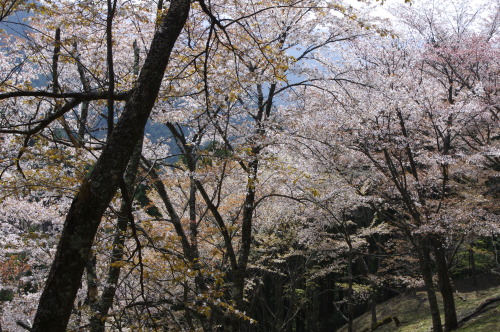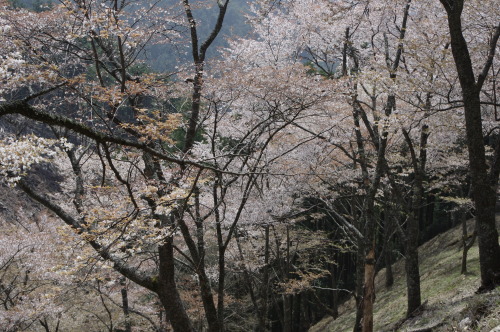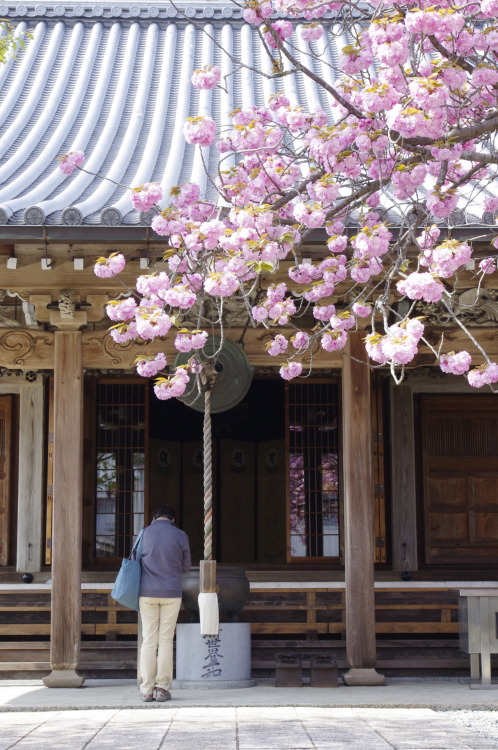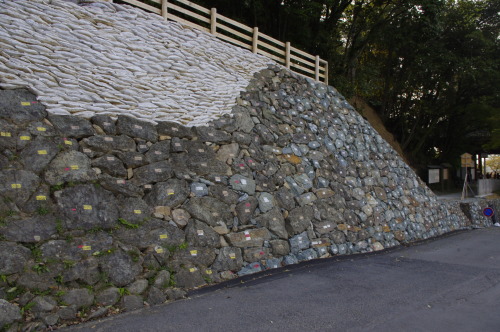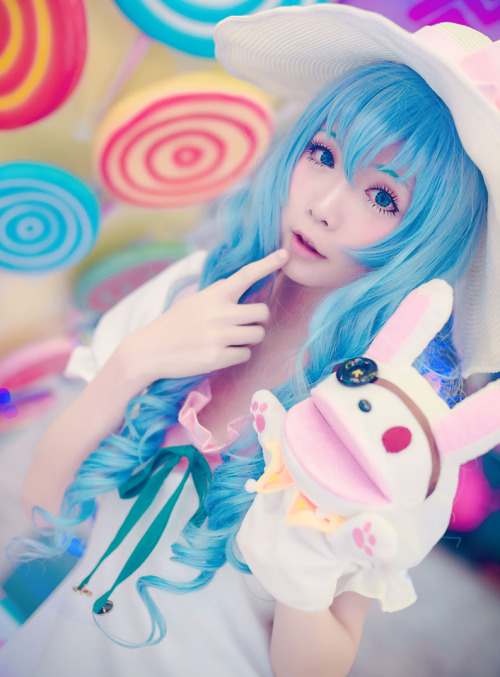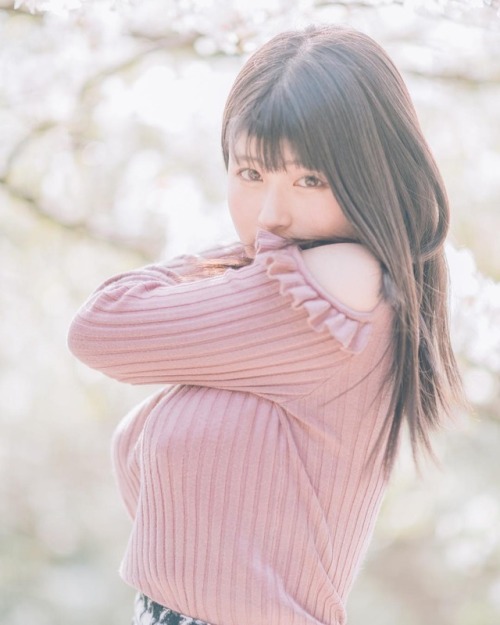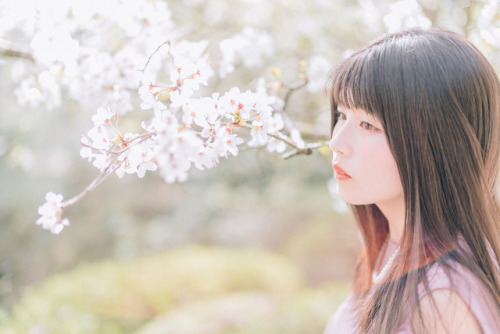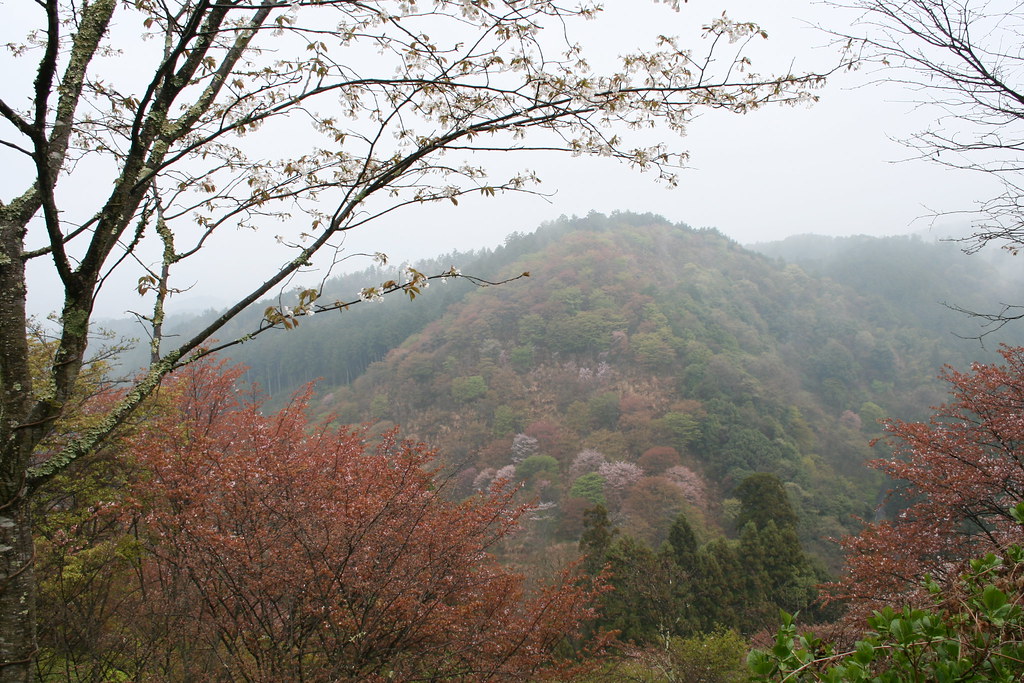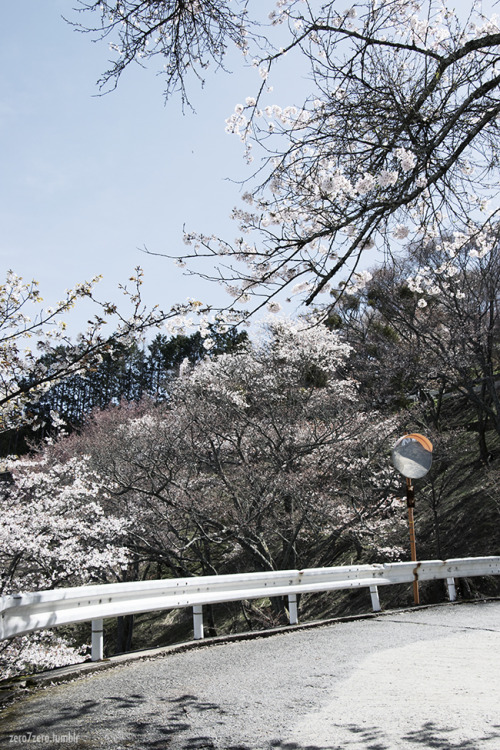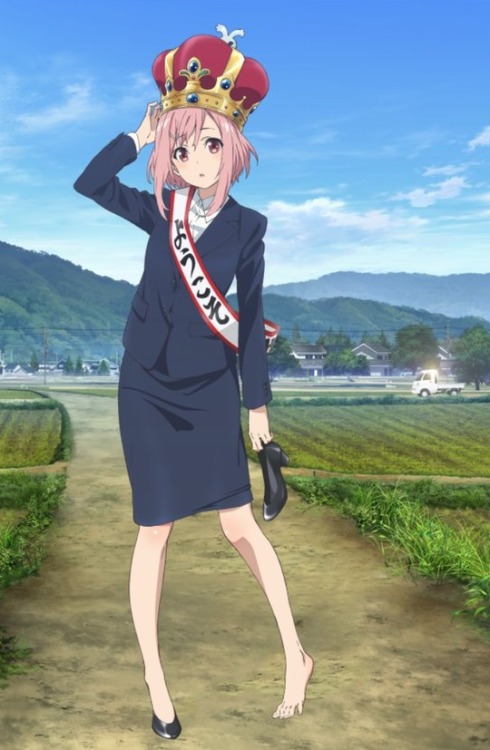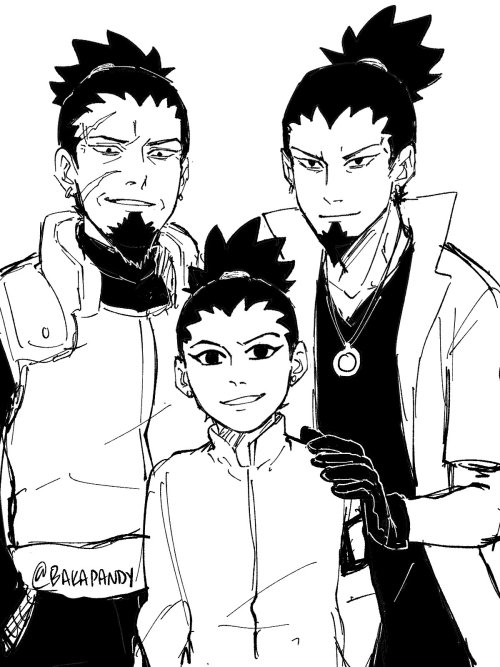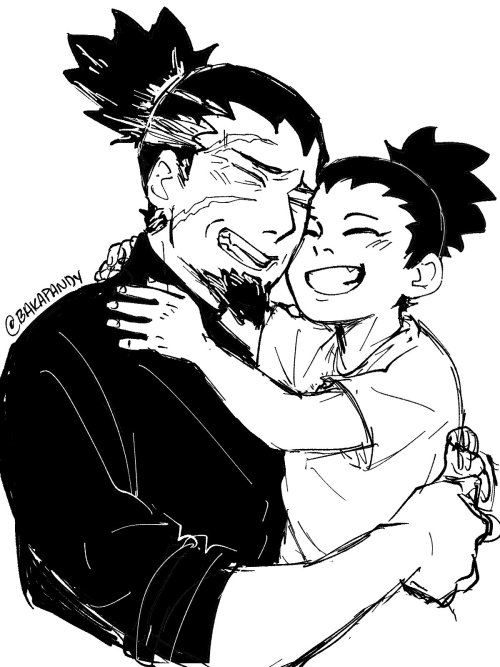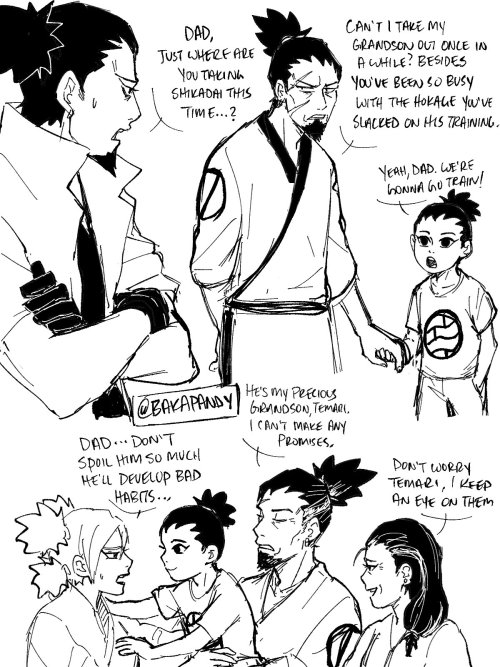#yoshino
吉野弁財天(Sakuramotoboh Temple : Yoshino.Nara)
桜本坊内にある吉野弁財天のお堂。
役行者は一千日の修行で蔵王権現を感得した際、最初に現れた弁財天のやさしいお姿を見て、「人を救うためにはもっと厳しいお姿の仏様を」と願って蔵王権現のお姿を得たと言われます。
というお話を、ふんわりやわらかい八重桜に包まれたお堂をカメラに納めながら思い出していました。
Post link
桜本坊(Sakuramotoboh Temple : Yoshino.Nara)
吉野に桜が多い理由は、修験道の開祖である役行者が大峰山上で一千日の修行を行った際、蔵王権現を感得し、その像を彫り込んだのが桜であったという説がひとつ。
そしてもうひとつは、吉野の日雄離宮に身を隠していた大海人皇子が、ある冬の日、桜が満開に咲き誇る夢を見て、皇位争いに勝利するお告げを受けたという説。
皇子は皇位に就いて後、天武天皇となり、夢に出てきた桜のあった場所に寺を建立した。
それが現在の桜本坊であると言う。
どちらにせよ、後の世の人たちが御神木として手に手に桜の苗木をお供えしたのが、今の一目千本の絶景を作ったのには違いない。
皇子の見た桜は、一本きりの木が咲く夢だったのだろうか。
それとも、屋敷中の桜が真冬に一斉に咲き誇る夢だったのろうか。
私はなんとなく後者のような気がしている。
みんなの願い事が叶いますように。
Post link
如意輪寺(Nyoirinji Temple : Yoshino/Nara)
山の峰越しに見える如意輪寺。
近くに見えても、間には深い谷を挟む。
修行を重ねた修験者なら、谷と谷をこともなく渡って行き来したのだろうか。
そりゃ天狗伝説も生まれるわな、と実感してしまう。
この立地、なかなかきびしいぞ…
Post link
金峯山寺蔵王堂(Kinpusenji Temple Zaoh-doh : Yoshino. Nara)
日本の国宝であり、世界遺産「紀伊山地の霊場と参詣道」の構成要素のひとつにも指定されている、金峯山寺蔵王堂。
堂内には蔵王権現が祀られています。
本尊である3体の金剛蔵王権現は秘仏とされ、常にお姿を拝見することはできませんが、特別な機会には一般にも拝観を許され、お近くで拝ませていただくことができます。
全高約7メートルという三体の立像。
静かな堂内で見上げる姿は、やわらかいような強いような、おそろしいような、不思議な感覚にとらわれます。
Post link
石垣の修復(Kinpusenji Temple : Yoshino.Nara)
奈良県吉野の金峯山寺脇の石垣。
2012年の4月に訪れた時には、石垣の修復が行われていました。
吉野山の峰上に町並みが連なる吉野は、傾斜がきつく、平らな土地の少ない場所。
そこに蔵王堂始め、金峯山寺の建物を支えるために作られた石垣は、小振りながらも膨大な数の石が使われています。
それらのひとつひとつに印をつけ、修復前と同じ位置へ戻せるようにしながら作業が進められます。
修復後はまた何百年と金峯山寺の基礎を支えていくのに違いありません。
緻密な作業に頭の下がる思いです。
Post link
Today is one of those happy occasions where I actually have a photo of the place mentioned in the poem(s) I am going to translate/discuss… and even with a somewhat appropriate natural phenomenon (fog trailing across the peak) - although no river in sight. Regardless, this is in the Yoshino Mountains in early April 2007, when I took a day trip down to see the famous cherries. Those cherries are not quite as famous yet in the period of MYS, so there’s nothing about them in these poems, which really only feature Yoshino due to it being the site of the cremation of the maiden for whom these elegies were composed. Nevertheless the cherry blossoms trees scattered throughout the mountain are what make Yoshino still a part of the cultural imaginary in Japan, and that was the inspiration for my trip (well that and Heian literature), but next time I’ll have to remember to think of the poor drowned Izumo no otome while I’m there (hopefully later this year!).
溺死出雲娘子火葬吉野時柿本朝臣人麻呂作歌二首
Two verses by Kakinomoto no Asomi Hitomaro, upon the cremation in Yoshino of Izumo no wotome, who had drowned
山際従 出雲兒等者 霧有哉 吉野山 嶺霏(雨+微)
山の際ゆ出雲の子らは霧なれや吉野の山の嶺にたなびく
yama no ma yu/idumo no kora pa/kiri nare ya/yosino no yama no/mine ni tanabiku
From amongst the mountains/the girl from Izumo/is she now the mist?/that now on Mt Yoshino/trails across the peak?
八雲刺 出雲子等 黒髪者 吉野川 奥名豆颯
八雲さす出雲の子らが黒髪は吉野の川の沖になづさふ
yakumo sasu/idumo no kora ga/kurokami pa/yosino no kapa no/oki ni nadusapu
Myriad clouds thrust into the sky/the girl from Izumo/her black tresses/now float about in the pools/of the Yoshino river.
This is the first drowned maiden verse that I know of in MYS, although it doesn’t give much of a story other than to tell us that Hitomaro is composing at the funeral of a girl who drowned. But elegies for drowned maidens, and the tales of drowned maidens, are a persistent theme throughout the collection, and there seems to have been a certain aesthetic appeal to them, for they persist into Heian literature, albeit in different forms and generally more fleshed out (Unai no otome reappears in Yamato monogatari, and then you have Ukihime of the Genji Uji chapters, who is perhaps the most famous - although she survives). Women who cast themselves into the river, at the mercy of the tide, when faced with no other options, seem to have been a literary trope, but probably more than that - this was probably the “elegant”/”appropriate” way for a woman to die, when she needed to. Usually, this is portrayed as her choice - she chooses to seize control of her own fate and cast herself into the water; the fact that her death is later aestheticized by poets is a separate matter. She certainly doesn’t do it for them. In most cases that I know of where female suicide is aestheticized, however, it is because she is faced with an impossible situation in life, one which usually involves having to choose between two men and being unable to do so (not because she is conflicted, necessarily, but moreso because choosing one over the other or vice versa will result in negative repercussions beyond merely a scorned suitor - such as causing conflict within one’s group/village, or with another family/group/village). Her choice to sacrifice herself to avoid the negative ripples that might result from acting in life, is seen as beautiful - and being swept away by the waves, helpless, is somehow a method of death befitting that sort of sacrifice - admittedly, of course, this is all in the view of the male poets of the age. I am in no way endorsing this, mind you - simply noting this is a literary trope common from this time.
Here we don’t really get any background on Izumo no otome, other than that the manner in which she died was drowning, and she did so in the Yoshino River (information which we can garner from the second poem). We know she is then cremated on Mt. Yoshino, where Hitomaro imagines that the mist trailing over the peak is the smoke from her pyre (and therefore her, herself - a very similar notion with poem #428 in my previous post - girl = smoke from her fire = mist, with no real distinction or leaps of logic in between necessary). The fact that the drowned maiden was already a trope at this time, however, allows us to extrapolate and guess her story in some way mirrors the others (indeed, there is actually no direct mention of her having taken her own life here - we might think it was an accidental death, if it were not for the whole literary matrix that had already formed around the figure of the drowned maiden).
The first banka for this poor girl from Izumo (modern Shimane), who drowns so far away from home in Yoshino (near Fujiwara/Nara), begins with an epithet for Izumo (as does the second), “yama no ma yu.” Both “Yama no ma yu” and “Yakumo sasu” play on the name “Izumo” itself, which means “emerging clouds” - so in the first case, the clouds are emerging from between the peaks, and in the second, myriad clouds are being thrust up into the sky. This leads into the girl’s name, Izumo no otome (”The Izumo Maiden”), as we are not actually in Izumo here, but this use of makura kotoba, while decorating her name and honoring her home, also contrasts sharply with the “Yoshino” that appears in the fourth ku in both poems - and reminds us that the maiden was in a foreign land, far from home, when she died. Like the corpse that Hitomaro encounters by the wayside in poem #426, who had “forgotten his home” and died alone, far away, we get the sense that Izumo no otome died a lonely death. She’s just a young girl (”kora”) but tragically meets her end alone in a foreign land (politically, by this time, Izumo had been integrated into Yamato’s sphere of influence, but was likely still somewhat culturally distinct - as the Izumo no kuni fudoki would suggest - and her presence in the Nara area may have in fact been a political one, to cement ties been the Yamato center and Izumo - this would certainly explain a court poet such as Hitomaro’s presence at her funeral). Neither poem really seems to have a sense for who she is, either - Hitomaro certainly grieves for her death, but not really for her - it’s clear he probably didn’t know her personally, and there seems to be a good amount of distance as he’s viewing her (as smoke, and then as her hair floating in the river [good old synecdoche allowing him to talk about her corpse without actually talking about it]). He views her in much the same way he views the corpse from 426 - a body that has suffered a tragic end, but not necessarily anything more than that.
These two poems are very similar in terms of both structure and content - they mourn the maiden from a detached, even aestheticized point of view. The makura kotoba they use for Izumo is different, but the second ku is identical between the two; the first sees her in the scenery, the smoke from her pyre becoming the mist trailing over the mountains - the second sees her as part of the scenery, and brings us back to the moment and circumstances of her death in a way quite unsettling for a funeral, but perhaps important, to remind those present of the circumstances of the tragedy, and probably perhaps to ensure that her death is seen as a beautiful one, despite the pathos of her end, so young and in a foreign, far off place.
There are certainly more interesting banka out there - these are not the most exciting or emotive of even those I’ve looked at in volume 3 so far, but I think they are important for how they touch upon the drowned maiden motif and for how we begin to see death being aestheticized, rather than merely mourned, something which continues into Heian literature. Older banka focus on the biting pain of grief and the process of mourning - #427 is all about denial, for instance - but the step to making death beautiful, to making death some literary, is interesting. Perhaps this comes out of not knowing the girl in life, and merely composing as part of the ritual, as Hitomaro is doing here - it is hard to say - but there is certainly something beginning here. In any case, this poor girl of Izumo who died at one of the most picturesque places in Yamato… now I’ll think of her when I see the mist at Yoshino, for sure…
I may need to take a break from banka for my next post… too much death, too much pathos…
Am I the only one who wasn’t sad about junpei’s death? Like I was shocked and all that stuff but I didn’t feel sad Pls tell me someone can relate


Is it just me or-
Is it just me or the two protagonists from ‘Koi wo suru tsumori wa nakatta’ (I Didn’t Mean to Fall in Love) in some panels remind me of Eiji and Ash from Banana Fish? Talking about character design and art style, I mean.

- - -






